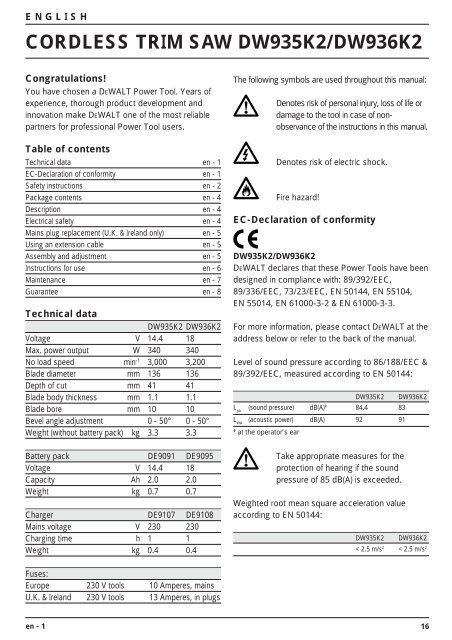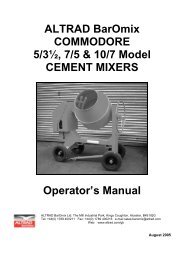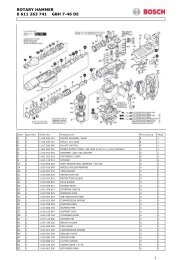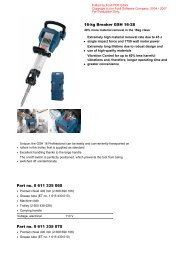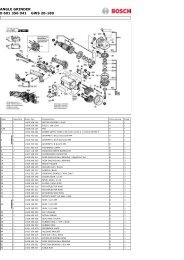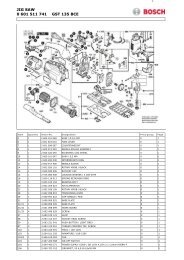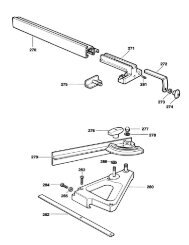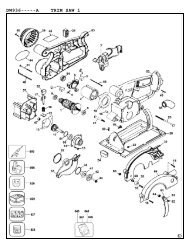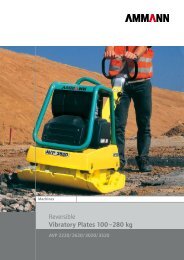Dewalt - DW936 - Cordless Circular Saw - Carey Tool
Dewalt - DW936 - Cordless Circular Saw - Carey Tool
Dewalt - DW936 - Cordless Circular Saw - Carey Tool
- No tags were found...
You also want an ePaper? Increase the reach of your titles
YUMPU automatically turns print PDFs into web optimized ePapers that Google loves.
ENGLISHCORDLESS TRIM SAW DW935K2/<strong>DW936</strong>K2Congratulations!You have chosen a DEWALT Power <strong>Tool</strong>. Years ofexperience, thorough product development andinnovation make DEWALT one of the most reliablepartners for professional Power <strong>Tool</strong> users.Table of contentsTechnical data en - 1EC-Declaration of conformity en - 1Safety instructions en - 2Package contents en - 4Description en - 4Electrical safety en - 4Mains plug replacement (U.K. & Ireland only) en - 5Using an extension cable en - 5Assembly and adjustment en - 5Instructions for use en - 6Maintenance en - 7Guarantee en - 8Technical dataDW935K2 <strong>DW936</strong>K2Voltage V 14.4 18Max. power output W 340 340No load speed min -1 3,000 3,200Blade diameter mm 136 136Depth of cut mm 41 41Blade body thickness mm 1.1 1.1Blade bore mm 10 10Bevel angle adjustment 0 - 50° 0 - 50°Weight (without battery pack) kg 3.3 3.3The following symbols are used throughout this manual:Denotes risk of personal injury, loss of life ordamage to the tool in case of nonobservanceof the instructions in this manual.Denotes risk of electric shock.Fire hazard!EC-Declaration of conformityDW935K2/<strong>DW936</strong>K2DEWALT declares that these Power <strong>Tool</strong>s have beendesigned in compliance with: 89/392/EEC,89/336/EEC, 73/23/EEC, EN 50144, EN 55104,EN 55014, EN 61000-3-2 & EN 61000-3-3.For more information, please contact DEWALT at theaddress below or refer to the back of the manual.Level of sound pressure according to 86/188/EEC &89/392/EEC, measured according to EN 50144:DW935K2 <strong>DW936</strong>K2L pA(sound pressure) dB(A)* 84.4 83L WA(acoustic power) dB(A) 92 91* at the operator’s earBattery pack DE9091 DE9095Voltage V 14.4 18Capacity Ah 2.0 2.0Weight kg 0.7 0.7Charger DE9107 DE9108Mains voltage V 230 230Charging time h 1 1Weight kg 0.4 0.4Take appropriate measures for theprotection of hearing if the soundpressure of 85 dB(A) is exceeded.Weighted root mean square acceleration valueaccording to EN 50144:DW935K2 <strong>DW936</strong>K2< 2.5 m/s 2 < 2.5 m/s 2Fuses:Europe 230 V tools 10 Amperes, mainsU.K. & Ireland 230 V tools 13 Amperes, in plugsen - 116
ENGLISHDirector Engineering & Product DevelopmentHorst GroßmannDEWALT, Richard-Klinger-Straße 40,D-65510, Idstein, GermanySafety instructionsWhen using Power <strong>Tool</strong>s, always observe thesafety regulations applicable in your country toreduce the risk of fire, electric shock andpersonal injury. Read the following safetyinstructions before attempting to operate thisproduct. Keep these instructions in a safe place!General1 Keep work area cleanCluttered areas and benches can cause accidents.2 Consider work area environmentDo not expose Power <strong>Tool</strong>s to humidity.Keep work area well lit. Do not use Power <strong>Tool</strong>sin the presence of inflammable liquids or gases.3 Guard against electric shockPrevent body contact with earthed surfaces(e.g. pipes, radiators, cookers and refrigerators).For use under extreme conditions (e.g. highhumidity, when metal swarf is being produced,etc.) electric safety can be improved by insertingan isolating transformer or a (FI) earth-leakagecircuit-breaker.4 Keep children awayDo not let children come into contact with thetool or extension cord. Keep all people awayfrom the work area.5 Store idle toolsWhen not in use, Power <strong>Tool</strong>s must be stored ina dry place and locked up securely, out of reachof children.6 Dress properlyDo not wear loose clothing or jewellery.They can be caught in moving parts. Preferablywear rubber gloves and non-slip footwear whenworking outdoors. Wear protective hair coveringto keep long hair out of the way.7 Wear safety gogglesAlso use a face or dust mask in case theoperations produce dust or flying particles.8 Beware of maximum sound pressureTake appropriate measures for the protection ofhearing if the sound pressure of 85 dB(A) isexceeded.9 Secure workpieceUse clamps or a vice to hold the workpiece. It issafer and it frees both hands to operate the tool.10 Do not overreachKeep proper footing and balance at all times.11 Stay alertWatch what you are doing. Use common sense.Do not operate the tool when you are tired.12 Remove adjusting keys and wrenchesAlways check that adjusting keys and wrenchesare removed from the tool before operating thetool.13 Use appropriate toolThe intended use is laid down in this instructionmanual. Do not force small tools or attachmentsto do the job of a heavy-duty tool. The tool willdo the job better and safer at the rate for whichit was intended.Warning! The use of any accessory orattachment or performance of any operation withthis tool, other than those recommended in thisinstruction manual may present a risk of personalinjury.14 Maintain tools with careKeep the tools in good condition and clean forbetter and safer performance. Follow theinstructions for maintenance and changingaccessories. Inspect the tool cords at regularintervals and, if damaged, have them repaired byan authorized DEWALT repair agent. Keep allcontrols dry, clean and free from oil and grease.15 Check for damaged partsBefore using the tool, carefully check it fordamage to ensure that it will operate properlyand perform its intended function.Check for misalignment and seizure of movingparts, breakage of parts and any other conditionsthat may affect its operation. Have damagedguards or other defective parts repaired orreplaced as instructed. Do not use the tool if theswitch is defective. Have the switch replaced byan authorized DEWALT repair agent.17 en - 2
ENGLISH16 Remove the battery packRemove the battery pack when not in use,before servicing and when changing accessories.17 Have your tool repaired by an authorizedDEWALT repair agentThis Power <strong>Tool</strong> is in accordance with therelevant safety regulations. To avoid danger,electric appliances must only be repaired byqualified technicians.Use only with DEWALT battery packs,others may burst, causing personal injuryand damageDo not expose to waterHave defective cords replacedimmediatelyAdditional safety instructions for battery packsFire hazard! Avoid metal short circuitingthe contacts of a detached battery pack(e.g. keys carried in the same pocket asa battery pack).+40 ˚c+4 ˚cCharge only between 4 °C and 40 °CDiscard the battery pack with due carefor the environment• The battery fluid, a 25-30% solution of potassiumhydroxide, can be harmful. In case of skincontact, flush immediately with water.Neutralize with a mild acid such as lemon juice orvinegar. In case of eye contact, rinse abundantlywith clean water for at least 10 minutes.Consult a physician.• Never attempt to open a battery pack for anyreason.Labels on charger and battery packIn addition to the pictographs used in this manual,the labels on the charger and the battery pack showthe following pictographs:100%Battery chargingDo not incinerate the battery packAdditional safety rules for circular sawsWhen sawing• Remove all nails and metal objects from theworkpiece before starting work.• Do not attempt to saw extremely smallworkpieces.• After switching OFF, never attempt to stop thesaw blade by pressing against the side of theblade.• Never put the saw down on a table or workbench unless switched OFF.100%en - 3Battery chargedBattery defectiveDo not probe with conductive objectsDo not charge damaged battery packsRead instruction manual before useOperational protection devices• The circular saw must only be used for cuttingwood or plastic.• Ensure that all devices screening the saw bladeare in perfect working order.• Never jam the saw blade guards.• Free a jammed saw blade guard immediately anddo not use the saw if the guard is jammed.• Do not remove the riving knife.• The riving knife should be correctly set;the distance between the toothed rim and theriving knife should be max. 5 mm and the heightdifference between the riving knife and thetoothed rim should be max. 5 mm (fig. E).18
ENGLISHChecking and changing the saw blade• Only saw blades conforming to the specificationscontained in these operating instructions maybe used.• <strong>Saw</strong> blades made of high alloy, high speed steel(HSS steel) should not be used.• Only sharp saw blades in perfect workingcondition should be used; cracked or bentsaw blades should be discarded and replacedat once.• Ensure that the saw blade is securely fixed androtates in the correct direction.Special applications• When cutting narrow workpieces(width less than 80 mm) longitudinally,use a rip fence guide along the longitudinal edge.• When sawing with the workpiece clamped tight,devices should be used to prevent the workpiecekicking back.• When sawing circular sections of wood usea device to hold the workpiece steady on bothsides of the saw blade to prevent slipping.• Ensure that pieces of wood sawn off theworkpiece cannot be caught up by the teeth ofthe saw blade and thrown in the air.Guard against kickback• Kickback occurs when the saw begins to stallrapidly and is driven back towards the operator.Release the switch immediately if the blade sticksor the saw stalls.• Keep the saw blades sharp.• Supports large panels near the cutting area.• Use a fence or straight edge guide when ripping;do not force the tool.• Do not remove the saw from the work duringa cut while the saw blade is rotating.Package contentsThe package contains:1 <strong>Cordless</strong> Trim <strong>Saw</strong>1 <strong>Saw</strong> blade1 Allen key1 Parallel fence (<strong>DW936</strong>K2)2 Battery Packs1 Battery Charger1 Kitbox1 Instruction manual1 Exploded drawing• Check for damage to the tool, parts oraccessories which may have occurred duringtransport.• Take the time to thoroughly read and understandthis manual prior to operation.Description (fig. A)Your DEWALT <strong>Cordless</strong> Trim <strong>Saw</strong> has beendesigned for professional sawing applications.1 ON/OFF-switch2 Lock-off button3 Front handle4 Blade lock button5 Dust spout6 Bevel adjustment knob7 Kerf indicator8 Riving knife9 Blade clamping screw10 Lower guard11 Lower guard retracting lever12 Shoe13 Depth adjustment knob14 Parallel fence (<strong>DW936</strong>K2)15 Battery packChargerYour DEWALT 1 hour charger accepts DEWALTbattery packs ranging from 7.2 to 14.4 V(DW935K2) or 7.2 to 18 V (<strong>DW936</strong>K2)15 Battery pack16 Release buttons17 Charger18 Charging indicator (red)Electrical safetyThe electric motor has been designed for onevoltage only. Always check that the battery packpower corresponds to the voltage on the ratingplate. Also make sure that the voltage of yourcharger corresponds to that of your mains.Your DEWALT charger is doubleinsulated in accordance with EN 50144.19 en - 4
ENGLISHMains plug replacement(U.K. & Ireland only)• Should your mains plug need replacing and youare competent to do this, proceed as instructedbelow. If you are in doubt, contact an authorizedDEWALT repair agent or a qualified electrician.• Disconnect the plug from the supply.• Cut off the plug and dispose of it safely;a plug with bared copper conductors isdangerous if engaged in a live socket outlet.• Only fit 13 Amperes BS1363A approved plugsfitted with the correctly rated fuse (1).• The cable wire colours, or a letter, will be markedat the connection points of most good qualityplugs. Attach the wires to their respective pointsin the plug (see below). Brown is for Live (L) (2)and Blue is for Neutral (N) (4).• Before replacing the top cover of the mains plugensure that the cable restraint (3) is holding theouter sheath of the cable firmly and that the twoleads are correctly fixed at the terminal screws.Never use a light socket.Never connect the live (L) or neutral (N)wires to the earth pin marked E or .Using an extension cableAn extension cord should not be used unlessabsolutely necessary. Use an approved extensioncable suitable for the power input of your charger(see technical data). The minimum conductor sizeis 0.5 mm 2 ; the maximum length is 30 m.Assembly and adjustment• Prior to assembly and adjustment,always remove the battery pack.• Always switch OFF the tool beforeinserting or removing the battery pack.Battery pack (fig. A)Charging the battery packWhen charging the battery pack for the first time,or after prolonged storage, it will only accept an80% charge. After several charge and dischargecycles, the battery pack will attain full capacity.Always check the mains prior to charging the batterypack. If the mains is functioning but the battery packdoes not charge, take your charger to an authorisedDEWALT repair agent. Whilst charging, the chargerand the battery pack may become warm to touch.This is a normal condition and does not indicatea problem.Do not charge the battery pack atambient temperatures 40 °C.Recommended charging temperature:approx. 24 °C.• To charge the battery pack (15), insert it into thecharger (17) as shown and plug in the charger.Be sure that the battery pack is fully seated in thecharger. The red charging indicator (18) will blink.After approx. 1 hour, it will stop blinking andremain on. The battery pack is now fully charged.The battery pack can be removed at any time orleft in the connected charger indefinitely.Inserting and removing the battery pack• Insert the battery pack into the grip until it clicksin place.• To remove the battery pack, press the tworelease buttons (16) simultaneously and pull thepack out of the grip.Depth of cut adjustment (fig. A & B)• Loosen the depth adjustment knob (13).• Move the shoe (12) to obtain the correct depthof cut.• Tighten the depth adjustment knob (13).For optimal results, allow the saw bladeto protrude from the workpiece by about3 mm (see inset in figure B).en - 520
ENGLISHBevel adjustment (fig. A & B)The bevel angle can be adjusted between 0° and 50°.• Loosen the bevel adjustment knob (6).• Set the bevel angle by tilting the saw shoe (12) untilthe mark indicates the desired angle on the scale.• Tighten the bevel adjustment knob (6).Shoe adjustment for 90° cuts (fig. A)• Adjust the saw to 0° bevel.• Retract the blade guard using the lever (11) andplace the saw on the blade side.• Loosen the bevel adjustment knob (6).• Place a square against the blade and shoe toadjust the 90° setting.• Loosen the hex nut with a wrench and move theadjustment screw so that the shoe will stop atthe proper angle. Secure the screw by tighteningthe hex nut.• If necessary, reset the pointer to “0”-position.Replacing the saw blade (fig. C & D)• Engage the blade lock button (4) and unscrewthe blade camping screw (9) by turning clockwiseusing the Allen key supplied with the tool.• Retract the lower blade guard (10) using thelever (11) and replace the blade. Reinstall thewashers (19 & 20) in the correct position.• Check the direction of rotation of the blade.• Thread on the blade clamping screw (9) by handto hold the washer in position.Turn counterclockwise.• Press the blade lock button (4) while turning thespindle until the blade stops rotating.• Tighten the blade clamping screw firmly using theAllen key.Adjusting the riving knife (fig. E)For the correct adjustment of the riving knife (8),refer to the inset in figure E. Adjust the clearance ofthe riving knife after changing the saw blade orwhenever necessary.• Adjust the depth of cut to 0 mm to access thefasteners of the riving knife.• Loosen the fasteners and pull out the riving knifeto its maximum length.• Adjust the clearance and tighten the fasteners.Instructions for use• Always observe the safety instructionsand applicable regulations.• Apply only a gentle pressure to the tooland do not exert side pressure on thesaw blade.• Avoid overloading. Should the toolbecome hot, let it run a few minutesunder no load condition.Prior to operation:• Make sure your battery pack is (fully) charged.• Make sure the guards have been mountedcorrectly. The saw blade guard must be in closedposition.• Make sure the saw blade rotates in the directionof the arrow on the blade.• Do not use excessively worn saw blades.Switching ON and OFF (fig. A)For safety reasons the ON/OFF-switch (1) of yourTrim <strong>Saw</strong> is equipped with a lock-off button (2).• Press the lock-off button to unlock the tool.• To run the tool, press the ON/OFF-switch.As soon as the ON/OFF-switch is released thelock-off switch is automatically activated toprevent unintended starting of the machine.Do not switch the tool ON or OFF whenthe saw blade touches the work piece orother materials.Holding and guiding the Trim <strong>Saw</strong> (fig. A)• Hold your DEWALT Power <strong>Tool</strong> by the main gripand the front handle (3) to guide the sawproperly.• For optimum results, clamp the workpiecebottom up.• Use the kerf indicator (7) to follow the line drawnon the workpiece. The kerf indicator lines up withthe left (outer) side of the saw blade.<strong>DW936</strong>K2 - Fitting the parallel fence (fig. F)• Fit the parallel fence (14) as shown.21 en - 6


